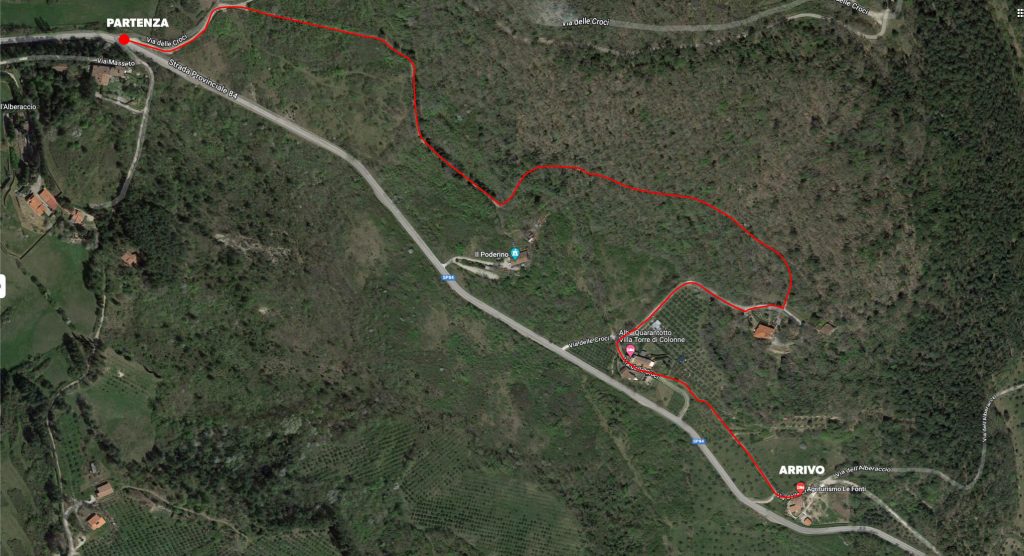
THE HISTORICAL-MONUMENTAL HERITAGE IN THE TERRITORY
Villa La Rocchetta
Elegant seventeenth-century building with Medicean forms, characterized by the presence of the terrace garden, typical of the ancient agricultural organization with examples of crops that have now fallen into disuse. Belonging to the Brunaccini family since 1580, La Villa maintained their property uninterruptedly until 1801. Around the Villa, a large property was organized consisting of about 5 farms, plus a mill and some wooded plots. Approximately 500 mt from the farm LE FONTI, the villa and its garden can be visited, upon reservation, by guests.
Villa di Masseto
Built in the fifteenth century, the Villa Masseto was built around an ancient observation tower, dating back to the eleventh century, and is the birthplace of the Guadagni family, a noble Florentine family who moved to Masseto at the end of the twelfth century. The Guadagni family joined the Guelph side, and participated in the battle of Monteaperti, where the Guelphs were defeated and exiled from Florence for several years, to return there in 1281, becoming very rich bankers.
Parish church of San Martino in Lubaco
It is located at the intersection with the ancient road that connected the settlements of Monteloro, Pagnolle, S. Brigida, Fornello, Doccia and Montefiesole. The building was built on the foundations of an older minor church and acquired the title of Pieve only in 1526. It has a Romanesque gabled plan without columns (demolished in the 18th century). The sober construction has a single nave closed by an apse, at the bottom of which we find a copy of a canvas by Benedetto da Empoli, depicting the Annunciation
Parish church of San Giovanni Battista in Monteloro
The church is mentioned for the first time in a bull of Celestino II of 1143. The Pieve, belonging to the bishops of Fiesole since the Middle Ages, has Romanesque origins. In the vicinity of the Church it is still possible to observe the remains of the ancient Castle of Monteloro.
Trebbio Castle
The Castle was built starting in 1184 by the De’ Pazzi family. Probably built around an original nucleus, it took on much of its current appearance between the 12th and 13th centuries. Its position on a ridge repeats, in a minor tone and almost with respect, that of the great fortress that the Guidi had erected on the Monte delle Croci. Right inside the Trebbio Castle, it seems that the noble Florentine family prepared the famous Congiura de ‘Pazzi aimed at eliminating Giuliano and Lorenzo de’ Medici, on April 26, 1478.
Torre a Decima Castle
The Castle of Torre a Decima is located in the heart of the ancient feud of the Guidi counts, at the base of Monte delle Croci, near Molino del Piano. The imposing manor after the extinction of the Saltarelli family, in the mid-fifteenth century, became the property of the Salviati and the Pazzi who remained its owners until the middle of the last century. The building, which dates back to the 12th-13th century, still retains the ancient tower and traces of the medieval fortification. In the 15th century, the interior was embellished with Renaissance-style arcades and loggias, while the walled perimeter was in turn surrounded by massive stone ramparts.
Parish church of S. Brigida
The building has a simple gabled façade with a single portal surmounted by a window. According to tradition, the church stands on the cave where Santa Brigida retired as a hermitage around the 10th century.
Sanctuary of Santa Maria delle Grazie al Sasso
The Sanctuary is located above the village of S.Brigida at an altitude of 565 mt on the ridge south-west of Monte Giovi, surrounded by coppice woods of chestnut, pine and oak and is part of the protected area; it can be reached via an easy path from the LE FONTI farmhouse in about an hour’s walk. Between 1484 and 1485 the Madonna appeared several times to two shepherdesses named Ricovera, admonishing them to “let the Florentine clergy and the people know that the Heavenly Mother invites everyone to return to read and meditate on the Gospel”, also asking that a church was to be erected in in that same place because, she told the two little sisters Ricovera: “Here I like to be venerated and from here to pour out thanks on those who ask me”.
The people who lived in those places did not believe in this story told by the two shepherdesses; but on 22 August 1485 the Madonna, with the baby Jesus in her arms, appeared to all the people, gathered there under the guidance of the shepherdesses. This event dissolved all doubts about previous apparitions and gave the decisive impetus to the construction of the Sanctuary, which was completed in 1504.
Agriturismo Le Fonti
via degli Alberacci 7 Pontassieve (FI)
tel. 376 0546711
info@agriturismolefonti.it
PIVA 06680590483
Copyright ® Agriturismo Le fonti 2022
fatto con amore da esociety marketing


